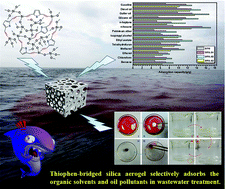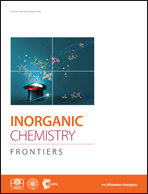A type of thiophene-bridged silica aerogel with a high adsorption capacity for organic solvents and oil pollutants
Abstract
A type of thiophene-bridged silica aerogel was prepared from tetraethyl orthosilicate (TEOS) and 2,5-divinyltrimethoxysilanethiophene (DVTHP) through a facile sol–gel reaction and ambient pressure drying process. DVTHP was synthesized from vinyl trimethoxysilane and 2,5-dibromothiophene through the Heck reaction. FTIR and solid-state 1H CP/MAS NMR indicated that the thiophene units had been successfully introduced into the silica aerogel network. SEM showed a co-continuous porous structure and the Brunauer–Emmett–Teller (BET) measurements showed a mesoporous structure that had a high surface area of 834 m2 g−1, an average pore size of 17.84 nm and a large pore volume of 3.72 cm3 g−1. This thiophene-bridged silica aerogel had superhydrophobicity with a water contact angle (CA) exceeding 174° and a sliding angle of less than 3°. The silica aerogel had better selectivities for less polar or non-polar solvents than for polar solvents. The introduction of the thiophene unit could improve the adsorption properties. The adsorption capacities for n-hexane and gutter oil were calculated as 17 g g−1 and 16 g g−1, respectively. Moreover, the samples exhibited good recyclability for organic solvents even after recycling 10 times in adsorption/desorption tests and the adsorption capacities were nearly unchanged from the maximum uptake capacities. The results indicated that these materials could be flexibly utilized as adsorbent materials to selectively adsorb organic solvents for wastewater treatment.



 Please wait while we load your content...
Please wait while we load your content...